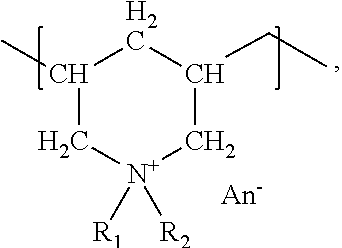Method of Reducing Water or Gas Permeability in a Subterranean Formation
a technology of subterranean formation and water or gas permeability, which is applied in the direction of sealing/packing, wellbore/well accessories, chemistry apparatus and processes, etc., can solve the problems of increasing operating expenditures, excessive water production, and fluid loss to highly permeable zones, so as to minimize fluid loss
- Summary
- Abstract
- Description
- Claims
- Application Information
AI Technical Summary
Benefits of technology
Problems solved by technology
Method used
Image
Examples
examples
[0052]About 0.55 cc of a 10 weight percent solution of poly-allylamine in tap water was mixed with about 100 cc of a 5 weight percent solution of polyacrylamide of molecular weight of about 500,000 in deionized water at room temperature. The mixture was left in a water bath of about 150° F. for about 15 hours to render a viscous gel. The viscosity of the gel was in excess of 100,000 cP at room temperature. The high viscosity of the gel indicates that the gel is impermeable to water and gas. The temperature stability of the formed gel was monitored and found to be stable for greater than 6 months from about 80° F. to about 350° F.
PUM
| Property | Measurement | Unit |
|---|---|---|
| temperatures | aaaaa | aaaaa |
| temperature | aaaaa | aaaaa |
| temperatures | aaaaa | aaaaa |
Abstract
Description
Claims
Application Information
 Login to View More
Login to View More - R&D
- Intellectual Property
- Life Sciences
- Materials
- Tech Scout
- Unparalleled Data Quality
- Higher Quality Content
- 60% Fewer Hallucinations
Browse by: Latest US Patents, China's latest patents, Technical Efficacy Thesaurus, Application Domain, Technology Topic, Popular Technical Reports.
© 2025 PatSnap. All rights reserved.Legal|Privacy policy|Modern Slavery Act Transparency Statement|Sitemap|About US| Contact US: help@patsnap.com



